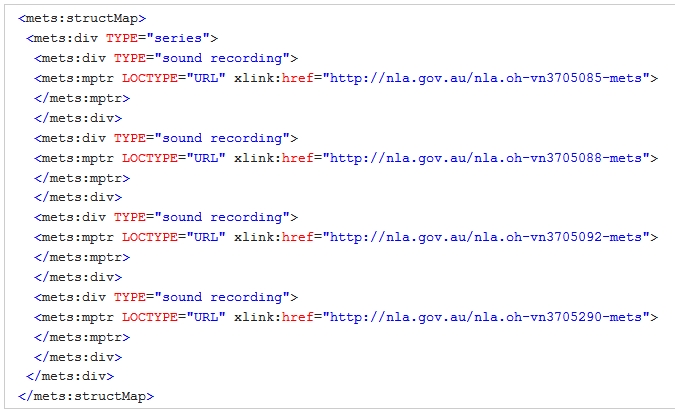The sound recording METS profile is not yet registered, but is based on the Australian METS Profile. This sound recording profile was developed for the purpose of delivering recordings through our Audio Delivery System. The profile only covers requirements for delivery, not for submission, ingest or archiving of sound recordings. The description below provides a basic explanation of what elements were included and why we included them.
Sound Recording Profile for Delivery
"If the purpose is to deliver an object as an OAIS Dissemination Information Package (DIP), a conforming METS document may contain only derivative files or pointers to derivative files, along with sufficient metadata to render or execute these files properly. In the case of complex hierarchical objects, components may be represented by another METS document and just referenced in the parent METS document." (Australian METS Profile 1.0, http://www.loc.gov/standards/mets/profiles/00000018.html)
Descriptive Metadata
The METS document will include a MODS record, as required by the Australian METS Profile.
We use a web service to extract records from our catalogue in MARC XML format and convert the records to MODS based on the stylesheets available from the Library of Congress MODS site.
Administrative Metadata
The METS document will include technical metadata necessary for delivery, e.g. bit rate for derivative files.
We currently use the Audio Technical Metadata Schema available here:
http://lcweb2.loc.gov/mets/Schemas/AMD.xsd
When the AES-X098 metadata standard is finalised, we may use that for describing audio technical metadata in METS documents.
This section could include rights metadata, but this will probably be covered adequately (for delivery) by the information in the MODS record.
Source and digiprov metadata will not be necessary for delivery of derivatives.
File Metadata
The METS document will include references to the locations of the files to be delivered.
We refer to the file location using our persistent identifier URLs, which resolve to the actual location on the file system.
Structural Map
There may be two forms of structural map for sound recording delivery -- one for collection level records and one for works. See the METS document under "Examples" to view a typical structural map for a sound recording work.
At this stage we are only using METS documents to deliver individual works, but theoretically we could use a collection level document to gather together a series of recordings for delivery. The collection level METS document would point to other METS documents describing the individual works. The structural map would look like this:

In the case of the National Library's collections, there will be multiple sound recordings within a series/collection, there may be multiple sessions within a sound recording, and there will normally only be one summary and transcript delivered for each sound recording.
Examples
Delivery of sound recording with linked TEI XML summary:
http://www.nla.gov.au/nla.oh-vn3603882
The METS document we use to deliver the sound files and summary: